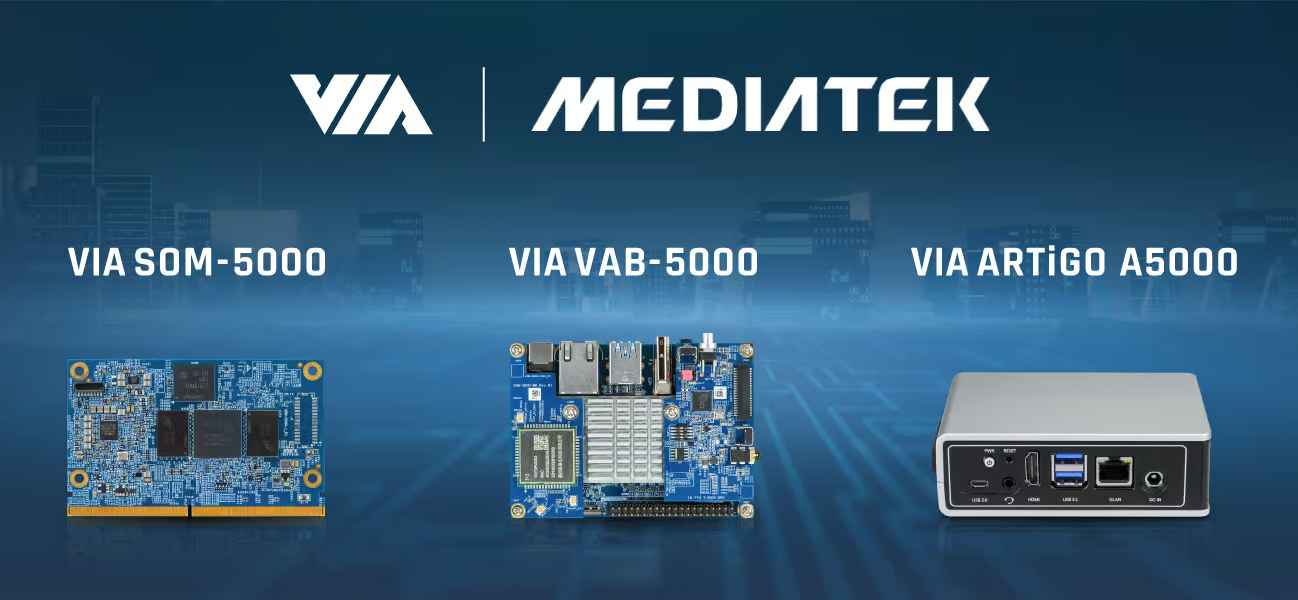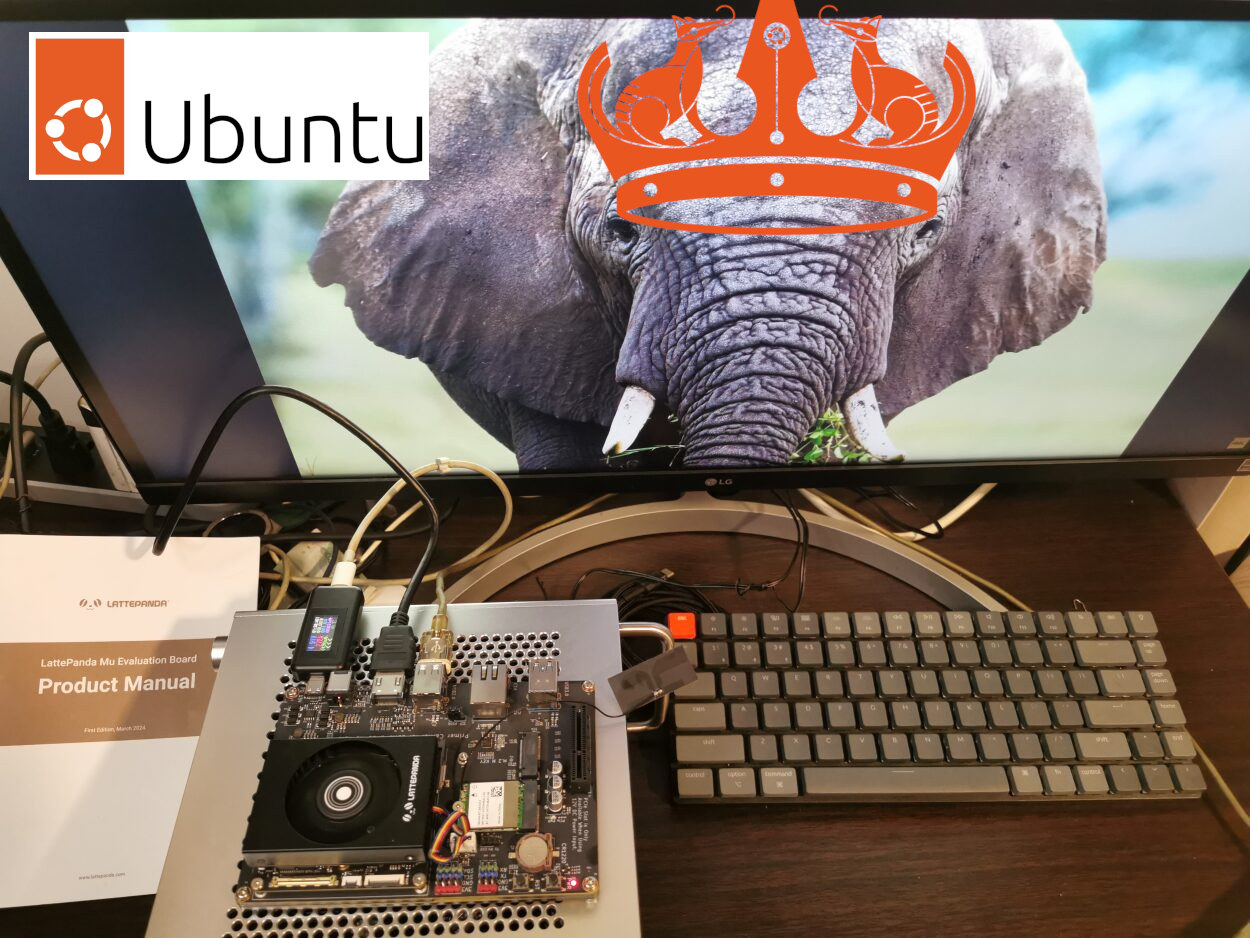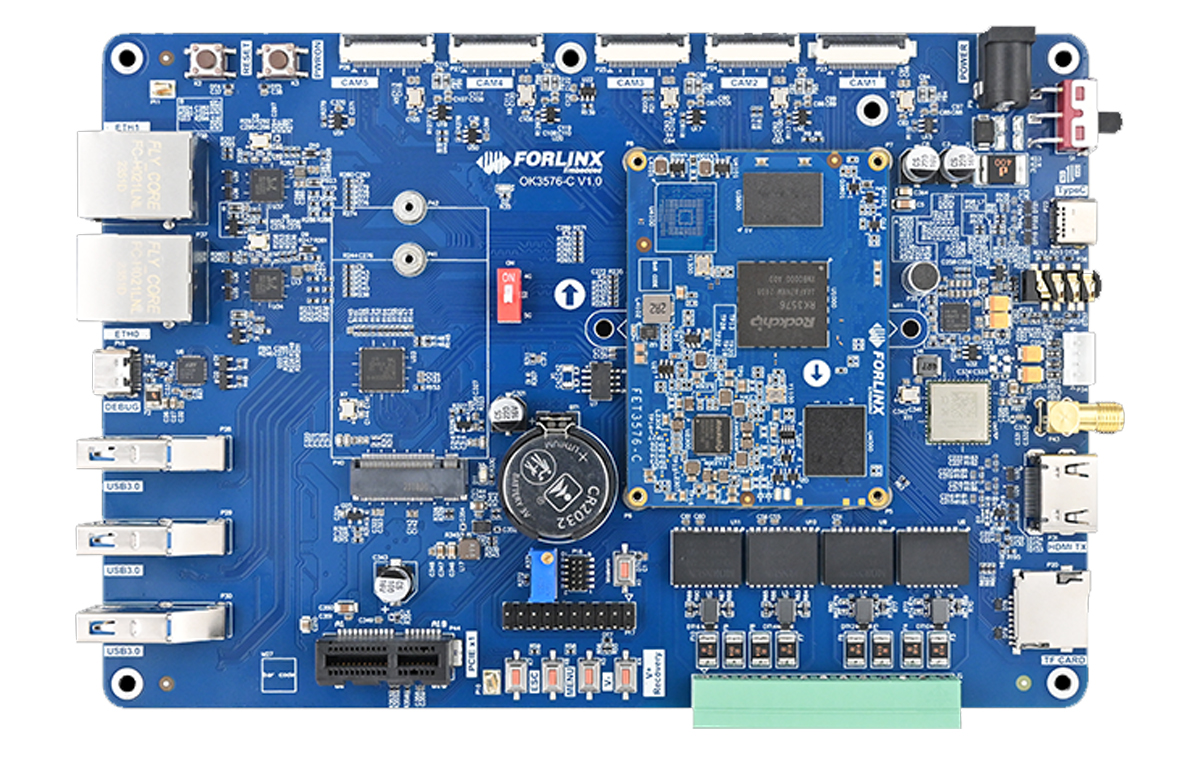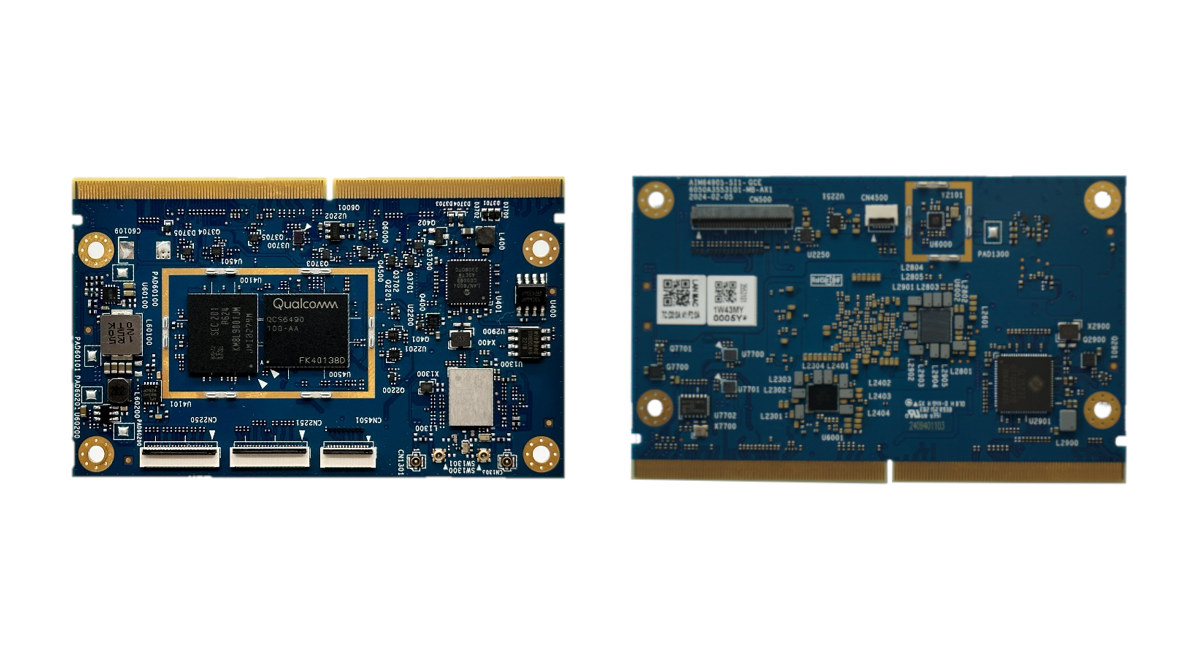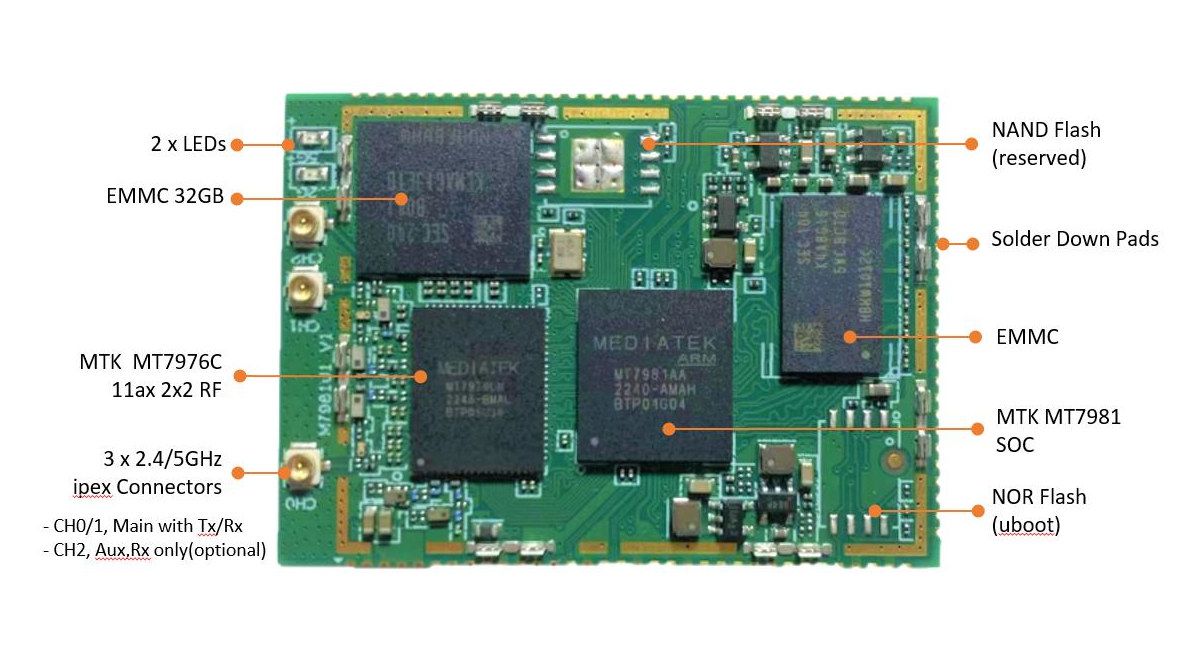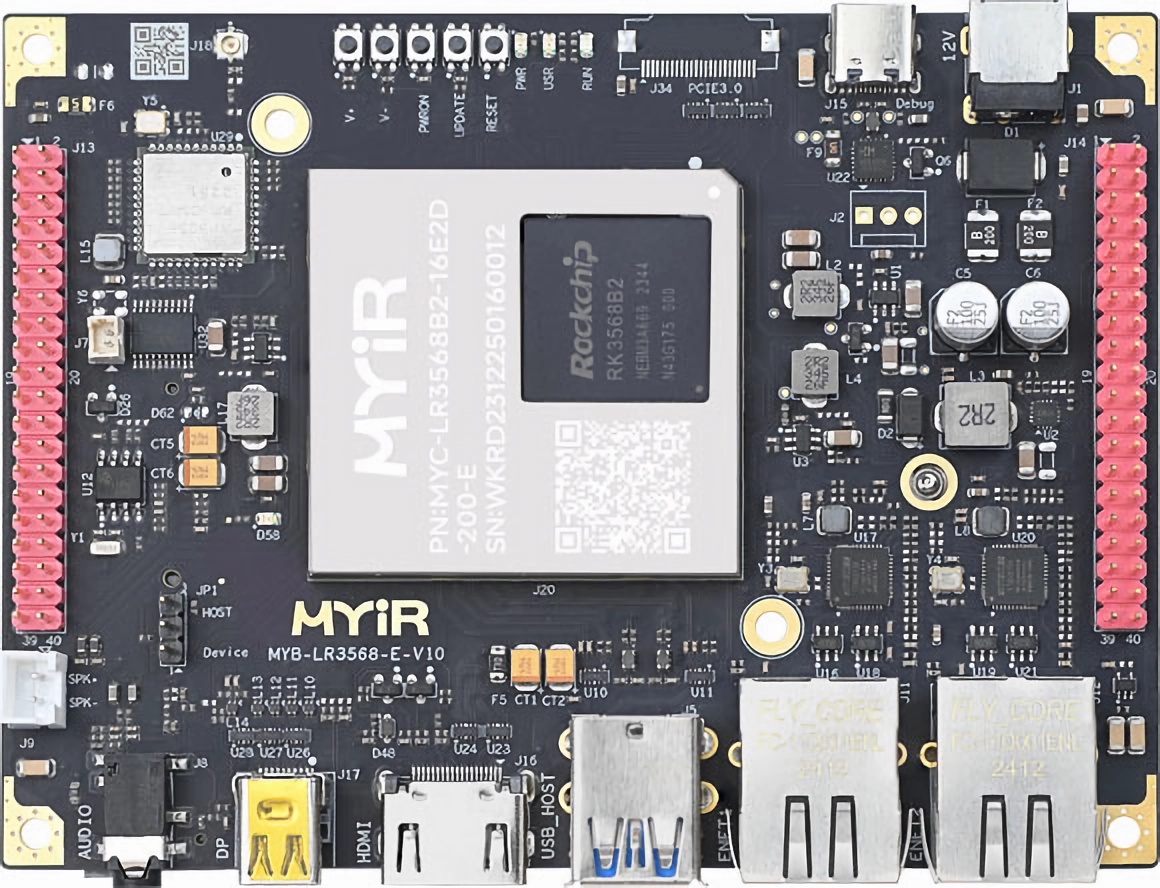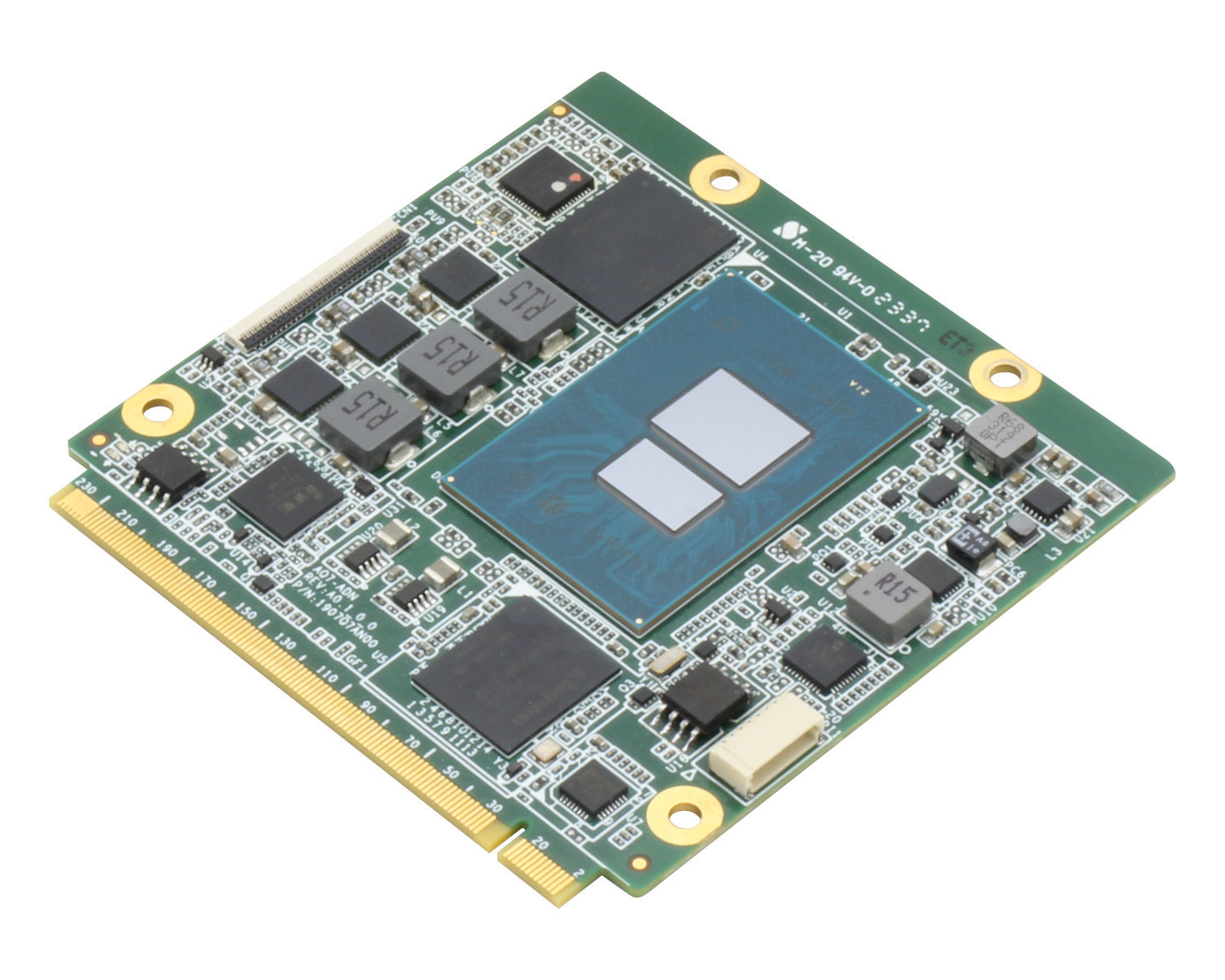VIA Technologies has launched three new Edge AI solutions based on the MediaTek Genio 700 mid-range Cortex-A78/A55 AI SoC with the SOM-5000 SMARC 2.1.1 system-on-module, VAB-5000 single board computer (SBC), and ARTiGO A5000 fanless embedded system. All three platforms come with 4GB or 8GB LPDDR4 memory, 16GB eMMC flash, gigabit Ethernet, video interfaces, and camera inputs, and are designed for intelligent edge computing across a range of industrial, commercial, and consumer applications. VIA SOM-5000 system-on-module Specifications: SoC – MediaTek Genio 700 (MT8390) CPU – Octa-core processor with 2x Cortex-A78 cores @ up to 2.2 GHz, 6x Cortex-A55 cores @ up to 2.0 GHz GPU – Arm Mali-G57 MC3 GPU with support for OpenGL ES 1.1/2.0/3.2, OpenCL ES 2.2, and Vulkan 1.0/1.1 APIs VPU Encoding up to 4Kp30 with H.265/HEVC or H.264 Decoding up to 4Kp75, AV1, VP9, HEVC, H.264 codecs supported AI accelerator – Mediatek DLA + VP6 with INT8, […]
Rockchip RK3576 castellated SoM powers development board with 12 analog camera inputs
Boardcon CM3576 is a system-on-module (SoM) Rockchip RK3576 with castellated holes that also powers the company’s EM3576 development board with 12 analog camera inputs among a range of other interfaces. We covered a few Rockchip RK3576 platforms in recent weeks including the Firefly ROC-RK3576-PC and Banana Pi BPI-M5 SBCs, and another system-on-module with the Forlinx FET3576-C with four 100-pin board-to-board connectors. The Boardcon CM3576 offers another option as a solderable SoM with castellated edges. Boardcon CM3576 SoM Specifications: SoC – Rockchip RK3576 CPU 4x Cortex-A72 cores at 2.3GHz, 4x Cortex-A53 cores at 2.2GHz Arm Cortex-M0 MCU at 400MHz GPU – ARM Mali-G52 MC3 GPU with support for OpenGL ES 1.1, 2.0, and 3.2, OpenCL up to 2.0, and Vulkan 1.1 NPU – 6 TOPS (INT8) AI accelerator with support for INT4/INT8/INT16/BF16/TF32 mixed operations. VPU Video Decoder – H.264, H.265, VP9, AV1, and AVS2 up to 8Kp30 or 4Kp120 Video Encoder – […]
LattePanda Mu Intel N100 SoM and carrier board review – Part 2: Ubuntu 24.04
We’ve already checked out the hardware for LattePanda Mu and tested it on Windows 11 using both the Lite Carrier Board and Full-Function Evaluation in the first part of the review. We’ve now had time to test the LattePanda Mu Intel N100 board with Ubuntu 24.04 to see how it performs in Linux with the following tests:
Initial system information
Benchmarks for CPU, disks, peripherals, and networking (GbE and WiFi)
Web and multimedia usage
Power consumption
Since LattePanda Mu is an x86 machine, we can create a boot disk from the Ubuntu 24.04 ISO as we would on a PC.
Forlinx FET3576-C Rockchip RK3576 SoM powers feature-rich OK3576-C board for AIoT applications
Forlinx FET3576-C SoM is a new System-on-Module built around the Rockchip RK3576 SoC which features four Arm Cortex-A72 and four Cortex-A53 cores made from a 22nm lithography process. The SoM is available with 2GB or 4GB of LPDDR4 RAM option and can be equipped with up to 32GB of eMMC storage. Additionally, it has 6 TOPS NPU power and supports standard peripherals like GbE Ethernet, Wifi, Bluetooth, LVDS, MIPI DSI, and much more. All these features make this device useful for IoT, edge computing, digital signage, and many other applications. The new FET3576-C SoM and its OK3576-C development board look very similar to the Forlinx FET3562J-C SoM and related board we covered earlier this month. But the main difference between the two is that the new one is built with the RK3576 SoC whereas the old one is built around the Rockchip RK3562(J) SoC. Previously we also saw that the […]
SagireEdge AI 600 SMARC SoM and devkit feature Qualcomm QCS6490 AIoT processor for Edge AI applications
Sagire AI’s SagireEdge AI 600 is a SMARC-compliant system-on-module (SoM) and a development kit based on Qualcomm QCS6490 octa-core Cortex-A78/A55 IoT processor and designed for Edge AI applications. The module comes with 8GB LPDDR5 and 128GB UFS storage, a WiFi 6E and Bluetooth 5.5 wireless module, a CAN Bus controller, and on-module camera and audio input connectors. Its MXM 3.0 edge connector exposes additional camera interfaces, a MIPI DSI display interface, PCIe Gen3 x2, gigabit Ethernet, a few USB interfaces, and a range of low-speed I/Os. SagireEdge AI 600 SoM specifications: SoC – Qualcomm QCS6490 CPU – Octa-core Kryo 670 with 1x Gold Plus core (Cortex-A78) @ 2.7 GHz, 3x Gold cores (Cortex-A78) @ 2.4 GHz, 4x Silver cores (Cortex-A55) @ up to 1.9 GHz GPU – Adreno 643L GPU @ 812 MHz with support for Open GL ES 3.2, Open CL 2.0, Vulkan 1.x, DX FL 12 DSP – […]
$39 Acelink SM81 MediaTek Filogic 820 WiFi 6 system-on-module runs OpenWrt 23.05 or Debian 11
Acelink SM81 is a compact (50x36mm) system-on-module based on the MediaTek Filogic 820 (MT7981A/B) processor with WiFi 6 and Ethernet connectivity designed for IoT applications such as routers, access points, and gateways. The wireless module ships with up to 1GB DDR4 memory, a 2MB NOR flash for the bootloader, a 32GB eMMC flash for Linux or an optional NAND flash, and exposes various I/Os such as gigabit Ethernet, USB 3.0, PCIe 2.1, UART, and more through castellated holes. Acelink SM81 specifications: SoC (one or the other) MediaTek MT7981AA (Filogic 820) dual-core processor @ 1.3 GHz MediaTek MT7981BA (Filogic 820) dual-core processor @ 1.3 GHz without PCIe interface System Memory – 1GB DDR4 @ 2133 Mbps Storage 2MB NOR flash for bootloader 16GB or 32GB eMMC flash for main OS (OpenWrt) Footprint for NAND flash Wireless Radio Mode – 2.4GHz 2×2 + 5GHz 3×3 MIMO via MT7976CN RF IC Radio Frequency […]
RK3568-based MYC-LR3568 system-on-module comes with up to 8GB RAM, 32GB storage for cost-sensitive Edge AI applications
MYIR Tech has announced the release of the Rockchip RK3568-based MYC-LR3568 Edge AI system-on-module (SoM) offered in a compact 381-pin expansion LGA package design. It features up to 8GB LPDDR4 RAM, 32GB eMMC flash storage, a power management integrated circuit, and various connectivity options. The base configuration of the MYC-LR3568 system-on-module offers only 2GB RAM and 16GB storage but the module supports up to 8GB RAM and 32GB eMMC storage. It supports several video codecs, including 4K 60fps H.265/H.264/VP9 decoding and 1080P 60fps H.265/H.264 encoding, for high-quality video playback and recording. The MYC-LR3568 SoM works with Debian and Linux operating systems. It is designed for cost-sensitive industrial applications including but not limited to IoT gateways, NVR storage, industrial control, human-machine interface (HMI), cloud terminals, and facial recognition systems. MYIR Tech’s MYC-LR3568 specifications: SoC – Rockchip RK3568 (B2 or J variant) CPU RK3568B2 – Quad-core processor with four Cortex-A55 cores @ 2.0 […]
AAEON AQ7-ADN – A Qseven 2.1 system-on-module with Intel Alder Lake-N CPU, four PCIe Gen 3 x1 interfaces
AAEON AQ7-ADN is a Qseven 2.1-compliant system-on-module based on Atom Processors x7425E, Intel Processor N, or Intel Core i3-N305 Alder Lake-N processor equipped with up to 8GB LPDDR5x and 64GB of eMMC flash storage. AAEON has already introduced Alder Lake-N COM Express and SMARC modules with the COM-ADNC6 and uCOM-ADN respectively, and the AQ7-ADN adds another system-on-module standard to its list of Alder Lake N-Series modules with a Qseven 2.1 SoM that offers four PCIe Gen x1 interfaces and a SATA storage interface. AAEON AQ7-ADN specifications: Alder Lake N-series SoC (one or the other) Intel Atom x7425E quad-core processor up to 3.4 GHz with 6MB cache, 24EU Intel UHD Graphics @ 1.00 GHz; TDP: 12W Intel Processor N50 dual-core processor up to 3.4 GHz with 6MB cache, 16EU Intel UHD Graphics @ 750 MHz; TDP: 6W Intel Processor N97 quad-core processor up to 3.6 GHz with 6MB cache, 24EU Intel […]


